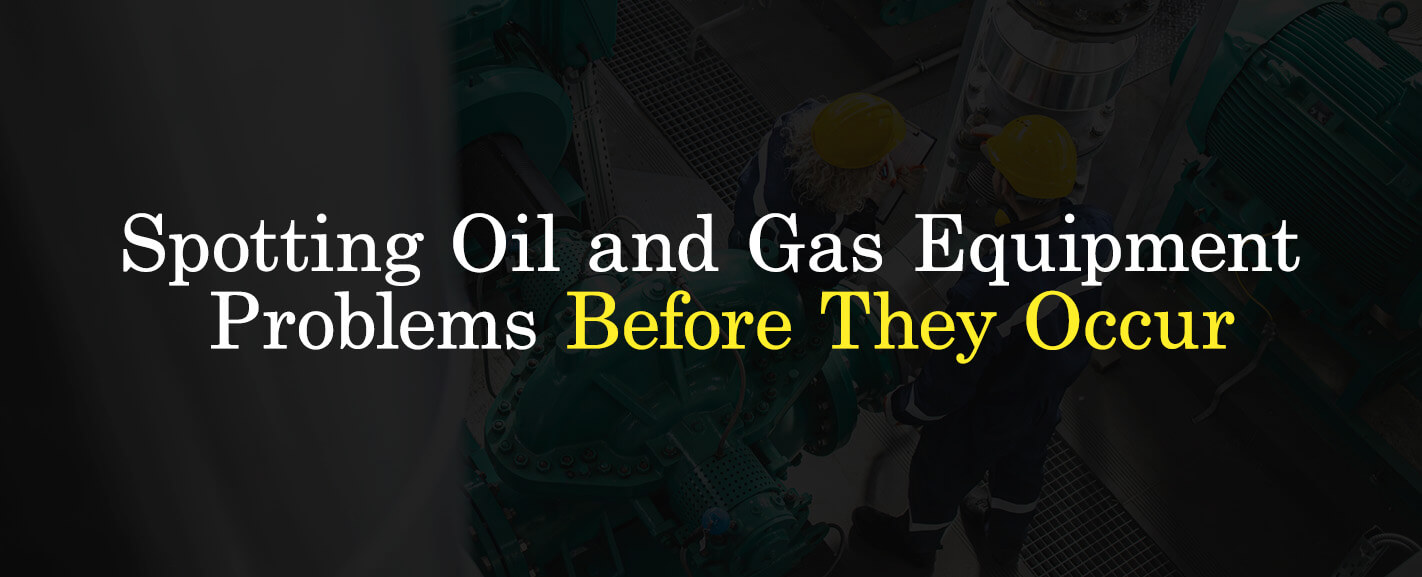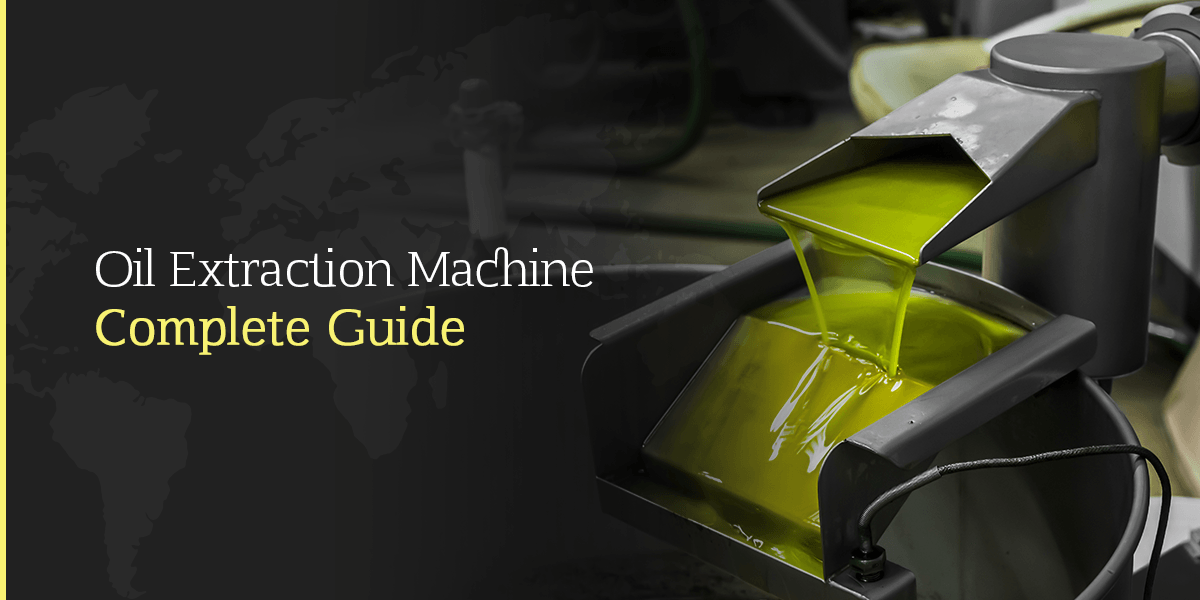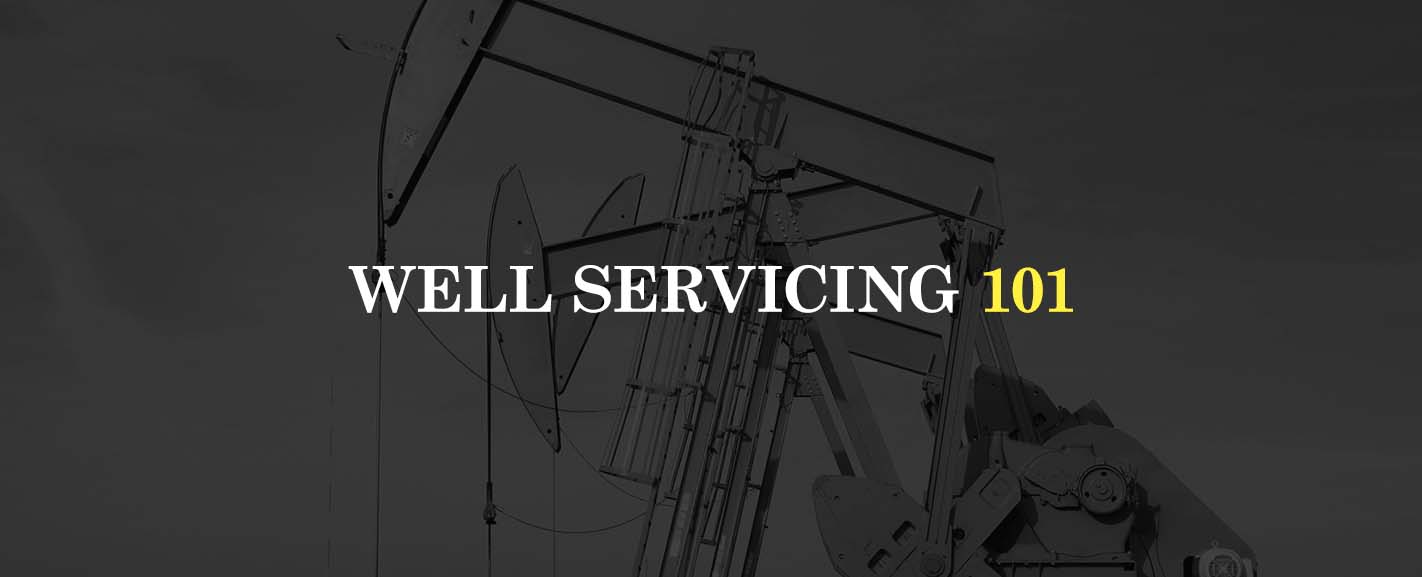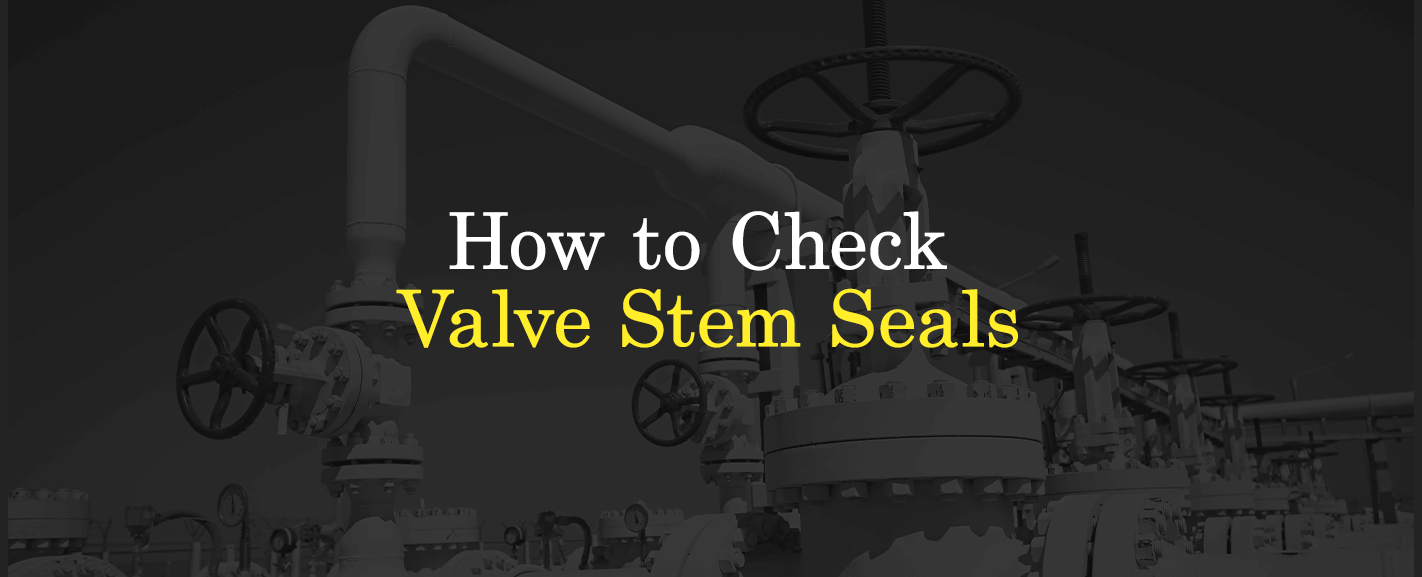Archive
Spotting Oil and Gas Equipment Problems Before They Occur

The oil and gas sector is one of the most important industries that fuels global economies. The industry uses complex equipment across the entire supply chain, starting from extraction. However, this equipment is not immune to failure or breakdown, especially when it operates in challenging conditions, such as high pressures, high temperatures, abrasive particulate matter and caustic chemicals. Spotting oil and gas equipment problems before they occur can help organizations avoid worse damage to the equipment, accidents and losses.
5 Safety Tips for Workers in the Oil and Gas Industry
Stressing the importance of safety in the oil and gas industry has always been a top priority. According to the Occupational Safety and Health Administration (OSHA), safety hazards and dangers for workers in this sector include everything from vehicle accidents to chemical burns. In environments containing heavy machinery, dangerous workspaces and potentially hazardous gases, workers must be fully trained and adequately equipped to mitigate risk.
What Are the Differences Between Elastomers and Plastics?
Plastics and elastomers are common types of polymers, but their similarity ends there. Polymers are made up of chains of monomers, which are molecules that can be chemically bonded together. The structure, chemical composition and behavior of polymers determine whether products are classified as plastics or elastomers.
A Guide to Oil Seals
Oil seals are essential for keeping lubricant and other necessary substances inside rotary shaft equipment and preventing debris from getting inside. These invaluable devices, also called rotary shaft seals, shaft seals, lips seals or elastomeric seals, protect the bearings of rotating shafts. In simple terms, oil seals form a protective barrier that separates the inside from the outside.
Oil Extraction Machine Complete Guide

From peanut butter and coconut oil to CBD products and fragrant soaps, plant oil extraction is the process behind many valuable items derived from agricultural products. Creating those products calls for an oil extraction machine. Oil extraction machines are a versatile type of machinery, helping agricultural businesses do more with their yields. These expeller pressers are typically based on a screw system, putting heat, friction and pressure to work as they squeeze oils out of different materials.
Silicone’s Benefits for Molded Rubber Products
![]()
When you're looking to create molded rubber products, you'll likely want to consider using silicone rubber. The many benefits of silicone rubber make it an attractive option compared to natural rubber. Those in the oilfield and agricultural industries regularly switch to silicone rubber due to its ability to perform in extreme temperatures, resist chemicals and provide exceptional sealing.
Well Servicing 101

Well servicing is an essential part of operating an oil or gas well. Servicing encompasses the tasks done during the rest of the life of the well after drilling. Therefore, it is essential to keep up with these maintenance activities. Regular servicing can prevent problems before major disruptions occur. Understanding the basics of well maintenance and well services will give you a better appreciation for these tasks during the well's production life.
Elastomers and Rubbers — What's the Difference?

Both "rubber" and "elastomer" are used to describe the makeup of components, fixtures and parts across industries and often seem to describe different things. However, "rubber" and "elastomer" are two ways to describe the same thing — elastomer is a description for any type of elastic material, such as synthetic rubber, while rubber is a specific type of elastomer. "Rubber" is often used as a shorthand description for "natural rubber," which is different from its more common synthetic counterpart.
How to Check Valve Stem Seals

Valve seals precisely control the amount of oil entering the valve stem system, making them critical components in maintaining your engine’s compression levels. Having a valve stem seal that works correctly within any of your applications can save you time and money by eliminating the need for lengthy engine repairs and replacements. But how do you check for bad valve seals, and what signs should you be aware of?
The United States Is the Largest Crude Oil Producer in the World: How Pipeline Bottlenecks Might Impact That Status
Oil markets are currently undergoing significant changes. Demand that was once concentrated in developed countries and transportation fuels is increasingly shifting to Asian markets and the petrochemical industry. And perhaps more surprisingly, the United States is leading the expansion of the global crude oil supply.
The United States has long been the largest crude oil producer in the world. As of December 2022, the United States was producing a record 12,000 barrels of crude oil every day. This output signified a substantial increase in production since 2018, when the country became the number one crude oil producer in the world, surpassing leaders like Russia and Saudi Arabia.
However, staying atop the rankings as the largest crude oil producer will be a challenge and handling oil pipeline bottlenecks forms a substantial part of that undertaking. Below, we'll discuss some history of crude oil production, explore a few of the factors that led to the United States' rise and assess one of the major supply chain challenges in the oil and gas industry: pipeline bottlenecks.
The History of Crude Oil Production
For decades, Russia, Saudi Arabia and the United States have been three of the world's largest oil producers.
Russia
On the world stage, Russia and Saudi Arabia have long been major players in the production of crude oil. Imperial Russia first began producing substantial amounts of oil in the 1800s in the oilfields near Baku, located in present-day Azerbaijan. By the beginning of the 20th century, Russia supplied about 31% of the world's oil. Soon afterward, however, advances in Western technology caused Russian crude oil production to lag and by 1913, Russia was producing only 9% of the world's crude oil.
That figure changed, though, with the discovery of vast oilfields in Russia's Volga-Urals region during World War II. Serious drilling efforts there began in 1955, and by the end of the 1950s, Russia was again one of the world's major producers of crude oil, surpassing Venezuela and second only to the United States. When the Volga-Urals oil was exhausted, Russia's oil and gas industry turned to the Siberian oilfields. Western Siberia soon became the biggest oil-producing region in Russia's history and Russia remained a leading producer of crude oil throughout the decades to come.
Saudi Arabia
In Saudi Arabia, meanwhile, oil was first discovered in 1933, and the Arabian American Oil Company (Aramco), a partnership between the Saudi Arabian government and the Standard Oil Company of California, soon became a major player in the industry. The company built thousands of miles of pipelines in Saudi Arabia and began exporting billions of barrels of oil.
In 1973, because of the Arab-Israeli war of that year, several Middle Eastern members of The Organization of the Petroleum Exporting Countries (OPEC) placed embargoes on oil products from the United States and other countries in retaliation for those countries' support of Israel. These events drove up oil prices, precipitating the 1973 oil crisis in the United States and paving the way for Saudia Arabia to become the world's foremost oil-producing country. Saudi Arabia would remain in that position for over two decades.
United-States
The United States was the world leader in crude oil production from the beginning of the 20th century to 1974 but fell behind after the oil crisis of the 1970s.
U.S. crude oil production first began its substantial tick upward in 2011. Much of that growth came from the production of light, sweet crude oil grades. Much of that production took place in areas such as the Permian region in western Texas and eastern New Mexico, the Bakken region in North Dakota and Montana and the federal offshore waters in the Gulf of Mexico.
In February 2018, U.S. crude oil production surpassed that of Saudi Arabia for the first time in 20 years. In August of that year, the United States surpassed Russia in crude oil output as well. By late 2018, the United States produced about 18% of the world's crude oil. Eventually, the United States exceeded its largest competitors — Saudi Arabia and Russia — to become the world's leading producer of crude oil. Saudi Arabia followed in second place with 12%, and Russia had fallen slightly behind with 11%.
Since then, the United States has maintained its position as the primary crude oil producer in the world. More than half of the states in the U.S. take part in the production of crude oil. In 2022, the leading oil-producing state was Texas, which accounted for almost half of the crude oil production at 42.5%. Other top producers were New Mexico, North Dakota, Colorado and Alaska.
Compared to 2021, crude oil production for 2022 in the U.S. increased by 5.6%. In computation, that is 0.6 million barrels per day, totaling 11.89 million barrels per day for the entire year. The latest record showed that the U.S. produced 13,200 barrels per day in October 2023. The data established a considerable growth in production in contrast to the previous months, where the figures only ranged between 12,200 and 12,900. The most recent projections indicate that by 2025, U.S. crude oil production will surpass that of Russia and Saudi Arabia combined.
Because of the impact of the U.S. on the supply chain of oil, it supports millions of companies and domestic consumers, providing lower energy costs and ensuring secured energy. Additionally, the accessibility and affordability of crude oil support the development of new infrastructures that create more jobs. All these benefits help improve the overall economic growth. However, there's one key challenge that affects the economic benefit of crude chain production, and that is the bottleneck.
Factors That Contributed to the US' Historic Production Levels
Several different factors have contributed to the United States' historic recent production of crude oil.
Fracking
A substantial amount of the increase in production is attributable to the rise of hydraulic fracturing — or fracking — in the shale formations in North Dakota and Texas. The International Energy Agency (IEA) reports that in 2010, U.S. shale production was virtually nonexistent, while by 2019, U.S. shale production amounted to approximately 7 million barrels a day, with that figure projected to rise at least through 2024. The U.S. shale industry can respond to increasing global oil prices more readily than other sectors, so U.S. shale production could increase even more if prices rise.
Increased Global Demand
Since 2006, the global demand for crude oil has been steadily increasing. In 2010, the global demand for crude oil amounted to 86.4 million barrels a day. By 2020, that figure rose to 91.19 billion barrels a day. In China and India, especially, the demand for crude oil has been rising as the countries continue to industrialize. Ever since the massive growth in 2020, there has been no decline in the yearly production. The 2022 data accounted for 99.57 million barrels a day, estimated at up to 101.89 million barrels per day for 2023.
Plastics and Manufacturing
Increased demand for oil in plastics and manufacturing has also contributed to increased crude oil production. Despite many local efforts to minimize plastics consumption and promote recycling, the overall global demand for plastics and petrochemicals remains high.
The IEA believed that petrochemicals were in line to be the primary driver of demand for decades to come. Petrochemicals are oil and gas derivatives used in a variety of products, including plastics, packaging, textiles, fertilizers, detergents, consumer electronics, medical equipment and even rubber tires. They are also necessary for the manufacture of modern energy components such as solar panels, wind turbines, batteries, thermal insulation and electric vehicles. They will account for a third of the growth in the global oil demand through 2030 and almost half the growth through 2050, according to the IEA.
Increased Plane Travel
Increased plane travel has also accounted for some of the United States' increased crude oil production. According to the IEA, air travel has more than doubled since 2000 — for instance, 2022 saw a record 3.7 billion air travel passengers globally. While the pandemic affected global air traffic, it's steadily increasing. The demand for both passenger and freight aviation is predicted to remain robust well into the future.
Better Technology
Another contributor to the United States' recent success in crude oil production is the advent of better technology. The most significant developments have taken place in the field of drilling and completions, including horizontal drilling, extension and hydraulic fracturing. Progress in technology development over the past decade has tended to focus on the following areas of improvement:
- Sophisticated data acquisition, processing and visualization.
- Water conservation and protection, primarily through technology that allows for better water reuse.
- Materials science, especially in materials used for wellbore isolation and integrity.
- Increased reservoir recovery factors, primarily through stimulation.
- CO2-enhanced oil recovery (CO2 EOR), which enhances carbon sequestration.
- Oil spill prevention technology for deep- and ultra-deepwater applications
The Impacts of Pipeline Bottlenecks
Pipeline bottlenecks occur when more crude oil is produced than the existing infrastructure can transport. Infrastructure insufficiency often involves a lack of pipeline capacity, though it can also mean a shortage in the labor force or equipment necessary to move crude oil. The Permian Basin bottleneck in the United States is one such bottleneck. Currently, pipelines from West Texas to the Gulf Coast are full, and new pipeline projects intended to ease the burden are not yet operational.
Pipeline bottlenecks produce several adverse effects on the oil industry.
Dependence on Other Oil Sources
A pipeline bottleneck can result in dependence on external oil sources, despite the local region's massive production capacity. If the oil the region is producing cannot get to refineries, the region has no choice but to import oil from other sources. Reports show that pipeline bottlenecks have directly contributed to a slowdown in the once-rapid decline of U.S. oil imports. East Coast refineries, in particular, are heavily dependent on crude oil from abroad because of the lack of existing infrastructure to transport crude oil from Midwestern sites, such as the Bakken oilfield in eastern Montana and western North Dakota.
Even as the biggest producer of crude oil in the world, the U.S. imported crude oil and other key petroleum products in 2022. The importation was necessary to keep up with the domestic demand and supply the other markets outside the country. According to the U.S. Energy Information Administration, the country imported 6.28 million barrels per day and only exported 3.58 million barrels per day. Around 12% of crude oil imports were sourced from countries in the Persian Gulf.
Maxed-out Capacities
Maxed-out pipeline capacities back up the oil and gas supply chain and diminish its efficiency. Even if the region is producing hundreds of thousands of barrels of crude oil a day, its effective capacities are much lower and its outputs flatten if it cannot move those barrels to other regions and refineries.
Maxed-out capacities can also occur because the region doesn't have the space necessary to accommodate the numerous pipeline routes that would be necessary to alleviate the bottleneck. In this case, the oil supply chain may remain backed up even though oil production is high.
Economic Effects
Pipeline bottlenecks contribute to adverse economic effects — lowered oil prices chief among them. As pipelines fill to capacity, producers must sell their products cheaply as they run out of storage space. During mid-2018, Permian oil was selling at $13 to $16 a barrel below what its contracts would otherwise have been. While U.S. crude futures were trading at around $71 a barrel, shale oil from Midland, Texas — located in the Permian Basin — was selling at about $58 a barrel. However, consumers do not benefit from these lowered prices since the pipeline bottleneck forces U.S. producers to use less efficient, costlier methods of transportation like trains and trucks, thus driving consumer prices back up.
Revenue Loss
Those discounted oil prices lead to revenue losses for producers. In Canada, pipeline bottlenecks cost oil producers $20 billion in one year. As in the Permian Basin, Albertan oilfields have suffered from a shortage of pipeline infrastructure. The resulting glut of oil reserves has forced producers to sell off their oil at dramatically reduced prices. In September 2018, western Canadian oilfields were producing 4.3 million barrels per day, but pipeline infrastructure could accommodate only about 3.9 million barrels per day. As a result, western Canadian oil prices averaged $38.30 (USD) a barrel in 2018 instead of the $52.90 they would have commanded otherwise.
As pipeline bottlenecks imbalance the demand and supply, they contribute to economic losses by diminishing the revenues from oil exports. Diminished supply leads to diminished stores of oil available to be shipped abroad, and reduced exports lead to reduced profits overall. Due to these issues, major oil companies and independent producers that operate in the U.S. are widely affected. Even National Oil Companies (NOCs) with objectives that concern both commercial and national interests are impacted by these challenges.
How-to-Avoid-Pipeline-Bottlenecks
The oil industry can take several steps to help avoid pipeline bottlenecks and mitigate their adverse effects:
- Discover system bottlenecks: One of the first steps toward preventing pipeline bottlenecks is determining where they occur. Mapping and analyzing system flow to discover the source of a slowdown is advisable. One of the best ways to do this is to develop a simulation model that includes terminals, tanks, pipelines and oil batches. The model output could include batch movement history, terminal and tank usage capacity, and pipelines’ batch movement speed and throughput. Analysis of this data would enable oil companies to locate bottlenecks quickly and determine why they had occurred.
- Change design: Sometimes, oil companies must change their designs to alleviate pipeline bottlenecks. They might need to adjust terminals, pipelines or tanks or retrofit outdated equipment to better accommodate the flow of produced oil. They might also want to compare flow rates, pipe diameters, pressures and so forth with the design specifications of process equipment. Companies should also evaluate any design changes after the fact to assess the efficacy of their alterations.
- Add Infrastructure: Adding infrastructure is often a beneficial design change — building new pipelines increases the throughput capacity of an oil producer radically. Adding infrastructure may involve surmounting legal and regulatory barriers, however. Before pipeline projects can proceed, they should be able to demonstrate that they can comply fully with safety and environmental regulations so state and federal permits can be issued. Companies should also be able to cooperate fairly and humanely with the rightful owners of the land through which the proposed pipelines pass.
- Improve oilfield products: Starting at the beginning of the oil production process, better products can reduce on-site bottlenecks. The oilfield products manufactured by Global Elastomeric Products, for instance, can help alleviate on-site bottlenecks by ensuring that operations run smoothly, efficiently and safely and without backups. From blowout preventers to oil well casings to drilling machine parts and more, we have the long-lasting, high-quality products you need to keep your processes productive and your throughput high.
Contact Us for All Your Oilfield Production Needs
To improve your oilfield production and help reduce bottlenecks, partner with Global Elastomeric Products. We are ISO-certified, and our in-house design engineers can craft custom products that are just the right fit for your specific equipment and applications. We can provide both standard and custom designs and products and no project is too big or too small for our detail-oriented, experienced and knowledgeable team. Our quick turnaround and friendly customer service set us apart from the rest of the field and we guarantee that our products will be free from defects 100% of the time.
We are happy to answer questions about how you can improve your oilfield production. Contact us today to learn more.




